The Salesforce Associate certification exam is designed for those candidates who have a fundamental awareness of the Salesforce platform and are able to solve the challenges. In this post, we will talk about how to pass the Salesforce Certified Associate. Let’s start our Guide to Pass Salesforce Associate Certification Exam.
Who is the Salesforce Certified Associate?
A Salesforce Certification Associate is one who has basic knowledge of the Salesforce platform and has up to 6 months of Salesforce user experience. Certification Associate should be able to understand reporting, user administration, sharing, customization, and data management at a foundational level is also beneficial.
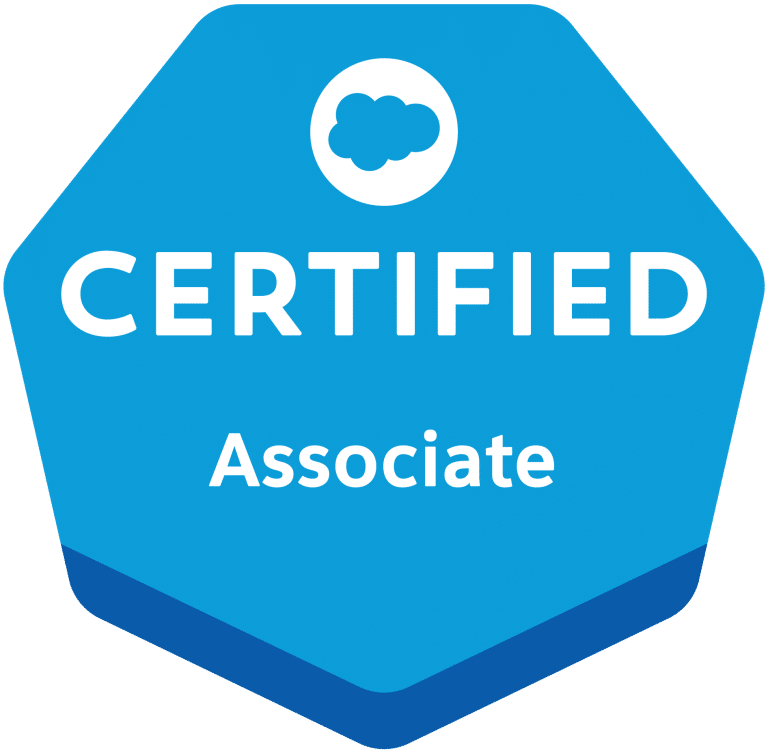
Salesforce Certification Associates don’t need technical expertise.
- Know the Salesforce 360 CRM platform.
- Able to resolve business requirements with the Salesforce platform
- Fundamental knowledge of Salesforce reports, security, customization, and data management.
About the Salesforce Associate Certification
Read on for details about the Salesforce Certified Associate exam.
- Content: 40 multiple-choice/multiple-select questions
- Time allotted to complete the exam: 70 minutes
- Passing score: 62%
- Registration fee: USD 75 plus applicable taxes as required per local law
- Retake fee: Free
- Prerequisite: None
Salesforce Associate Certification Exam Outline
This exam is divided into four parts.
- Salesforce Ecosystem: 32%
- Describe various resources available to learn and apply in-demand Salesforce skills.
- Given a use case, identify which Salesforce Customer 360 product offerings could be used.
- Describe how companies use Salesforce.
- Differentiate between various job roles and career paths in the Salesforce ecosystem.
- Navigation: 28%
- Identify how a user can locate and access necessary information.
- Given a scenario, identify where Salesforce customization takes place.
- Data Model: 25 %
- Explain the relationship between the core standard objects (account, contact, lead, opportunity, case).
- Given a scenario, determine which feature to use to ensure data visibility.
- Given a scenario, determine which tool to use to ensure data integrity.
- Reports and Dashboard: 15%
- Describe reports on Salesforce.
- Dashboards on Salesforce.
How to become a Salesforce Certified Associate?
As preparation for this exam, Salesforce recommends a combination of hands-on experience, training course completion, Trailhead Trails, and self-study in the areas listed in the Exam Outline section of this exam guide.
The self-study materials recommended for this exam include:
- Trailmix: Prepare for Your Salesforce Associate Credential
- Module: Salesforce Associate Certification Prep
- Check guide
Salesforce Certified Associate Practice question
Check out the trailhead module for Practice questions for Salesforce Certified Associate. Also, you can check Apex Hours FREE course for practice exam. I hope this sample Salesforce Associate Certification questions and answers will help you to clear your exam.

Topic to prepare for the Salesforce Certified Associate Exam
Here is a list of the topics in the Salesforce Associate Certification exam.
1. Salesforce Ecosystem: 32%
The Salesforce ecosystem drives the revenues and jobs created by Salesforce. The Salesforce ecosystem comprises 1) Salesforce, 2) Customer, and 3) Partners.
1.1. Various resources are available to learn and apply in-demand Salesforce skills.
Here are various resources available to learn and apply in-demand Salesforce skills:
- Trailhead.
- Trailhead Academy
- Salesforce Help Document
- Trailblazer Community
- IdeaExchange
Trailhead
It’s a free app that teaches the skills needed to be successful in the modern world of work. You can create Trailhead playground to develop and practice Salesforce skills within Trailhead.
- Trailhead Quests: Fun way to learn and win prizes.
- Trailmixes: You can create a custom learning path for your employees using Trailhead.
Trailhead Academy
Use Trailhead Academy empowers businesses to develop expertise across their organization with expert-led learning and credentials that build and validate Salesforce skills.
Salesforce help document
Product documentation, a glossary, and release notes are posted in Salesforce help.
Trailblazer Community Group
The Trailblazer Community helps you learn relevant skills, connect with other Trailblazers, and give back. Learn about different Salesforce events in 2023.
- Dreamforce: Dreamforce is the biggest yearly conference for Salesforce.
IdeaExchange
Salesforce IdeaExchange is a website where you can share your ideas related to Salesforce products and services.
1.2. Given a use case, identify which Salesforce Customer 360 product offerings could be used.
| Salesforce Product | Use |
| Marketing Cloud | Use Marketing Cloud Account Engagement to scale and automate marketing by improving alignment within teams. |
| Commerce Cloud | Use Commerce cloud to streamline the purchasing process, and personalize the buying experience and create a mobile-friendly shopping experience. |
| Experience Cloud | Empower customer (Self Service) and collaboration with partners. |
| Sales Cloud | Sales Cloud is a cloud-based application designed to help your salespeople sell smarter and faster by centralising customer information, logging their interactions with your company, and automating many of the tasks salespeople do every day. |
| Service Cloud | Service Cloud allows you to deliver service to every customer, anytime, anywhere. It is a part of Salesforce’s Customer Success Platform, an ecosystem of connected mobile and social tools powered by the cloud. |
| MuleSoft | MuleSoft is a vendor that provides an integration platform to help businesses connect data, applications and devices across on-premises and cloud computing environments. |
| Non-Profile Cloud | Nonprofit Cloud is a complete set of nonprofit technology solutions Salesforce.org built to connect your nonprofit with the people who care about your cause. |
| Salesforce Industries | Salesforce Industries started shortly after the acquisition of Vlocity. Salesforce Industries is the new name of Vlocity, a tech startup that was officially acquired by Salesforce. |
1.3. Describe how companies use Salesforce
Salesforce developer org
You can use Salesforce developer org to learn development and try a new feature before implementing it for its client.
Types of instances
A Salesforce sandbox is an isolated copy of your organization’s production environment that is used for development and testing purposes. Your production environment has your live data and active users logging in.
Type of Sandbox in Salesforce
- Developer Sandbox: Developer sandboxes are special configuration sandboxes intended for coding and testing by a single developer. Developer sandboxes are limited to 200 MB of test or sample data. You can refresh a Developer sandbox once per day
- Developer Pro Sandbox: The main difference between this and Developer is the amount of data that can be stored. It also grabs some product data from production. It can only include up to 1 GB of data. You can refresh a Developer Pro sandbox once per day.
- Partial Copy: Partial Data sandboxes include all of your organization’s metadata and add a selected amount of your production organization’s data that you define using a sandbox template.
- Full Sandbox: Full sandboxes copy your entire production organization and all its data, including standard and custom object records, documents, and attachments. You can refresh a Full sandbox every 29 days.
Multi-tenant environment
Salesforce is based on Multitenant Architecture.
1.4. Differentiate between various job roles and career paths in the Salesforce ecosystem
Various Salesforce Career options are available in the Salesforce ecosystem. We will see different career choices you have or different job profiles that are available in the Salesforce job market.
| Name | Description |
| Salesforce Associate | One who has basic knowledge of the Salesforce platform and has up to 6 months of Salesforce user experience. |
| Salesforce Admin | As a Salesforce Administrator, it is a very important responsibility to correctly set up the Customer Org, their roles/ responsibilities, and Hierarchy in the system. You also set up which login user should see what kind of data- controlling the visibility of the screens, etc. |
| Developer | Being a consultant means having a “Know How” of the system. Not just following what’s required to be done- but also to be able to suggest the processes that are industry best practices. A Salesforce functional consultant is responsible for creating a Functional Deign Document for the whole set of requirements for the Salesforce team and be able to suggest process improvements based on Salesforce Best Practices. |
| Salesforce Business Analyst | Right from the requirement capture, running customer workshops, requirement elicitation, interacting with different customer user groups, creating the business requirement document (BRD), capturing the as-is and to-be processes- this all is taken care by a Business Analyst(BA). |
| Salesforce Consultant | A program manager sits at the top of this hierarchy. This role cuts across all the teams similar to Enterprise Architect/Program Architect but is responsible for managing the customer teams, vendor teams, delivery teams, testing teams, etc. on an overall program delivery level |
| A Salesforce Designer | Designers work across the streams and systems and have a bigger additional responsibility to be able to see how Salesforce would fit in the overall program ecosystem. They would come up with the overall program-level design- a functional design that covers the whole program, which includes interacting systems and any inbound and outbound communications. |
| Sales Professional | Sales professionals are excellent communicators and relationship builders, and they enjoy helping others succeed. |
| Marketing Manager | Marketing managers understand the art and science behind creating targeted marketing campaigns that connect with customers. Marketers bring big ideas to the table that drive impressive results. |
| User Interface/User Experience Designer | User experience (UX) designers are problem solvers, working cross-functionally with product managers, engineers, content creators, and executives to create and refine a product vision. |
| Salesforce Architect | To stitch through all the requirements across the project and to be able to suggest the best approach for all the set of requirements, an Architect plays a pivotal role. The Salesforce Architect is responsible for gathering technical and functional details from each of the track tech specialists. |
| Program Manager | Similar to the functional consultant role- but Designers work across the streams and systems and have a bigger additional responsibility to be able to see how Salesforce would fit in the overall program ecosystem. They would come up with the overall program-level design- a functional design that covers the whole program, which includes interacting systems and any inbound and outbound communications. |
2. Navigation: 28%
2.1 Given a scenario, identify how a user can locate and access necessary information.
Related lists: Includes details and links to other records.
My Favorites: You can add records or reports in my favorites
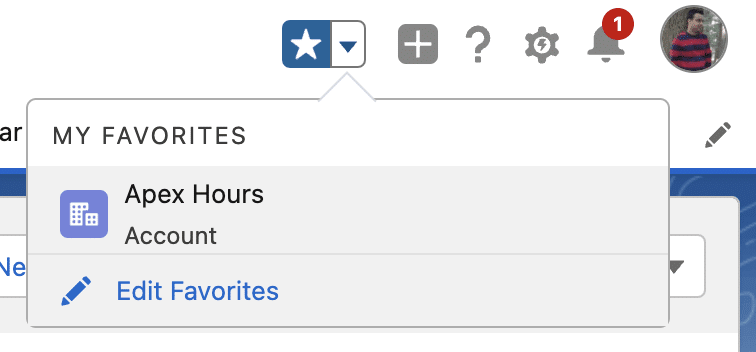
Tab: The Starting points for viewing, editing, and entering information for a particular object.
Recycle Bin: Use to view and restore deleted records. You can access the Recycle bin from App Launcher in the Lightning platform.
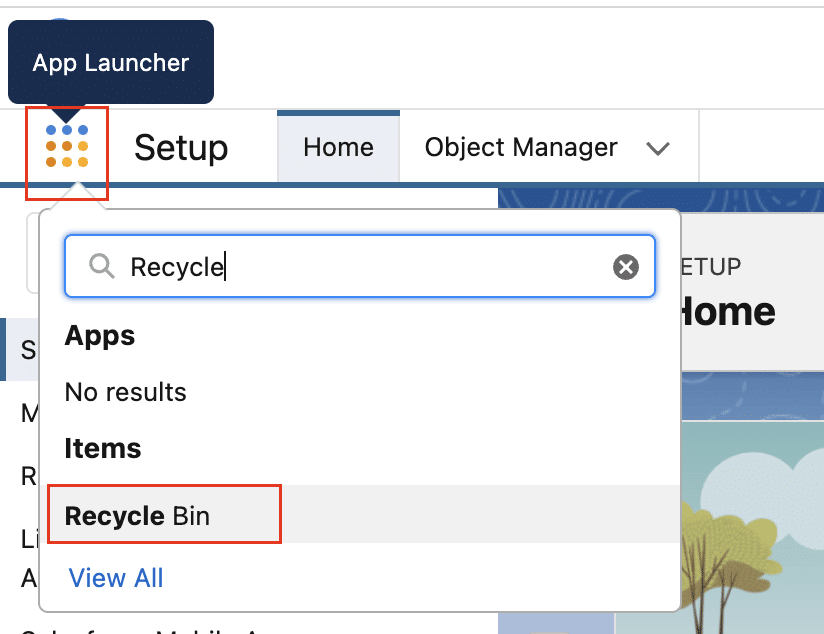
2.2 Given a scenario, identify where Salesforce customization takes place.
User settings
Users can change their profile from the settings icon under their profile icon. He can change his email address, his password etc.
- You cannot delete the user in Salesforce. You can only deactivate the user to free up the licenses.
Setup
The Setup menu is accessed from the Setup link on the upper-right corner of any Salesforce page. The Setup menu is organized into goal-based categories: Administer, Build, Deploy, Monitor, and Checkout.
Personal settings
Personal settings, which all Salesforce users can edit, are available from a separate My Settings menu. User settings ➡ My Personal information.
- From my email Settings, you set your email signature as well.
- You can also change your personal Language and Time Zone.
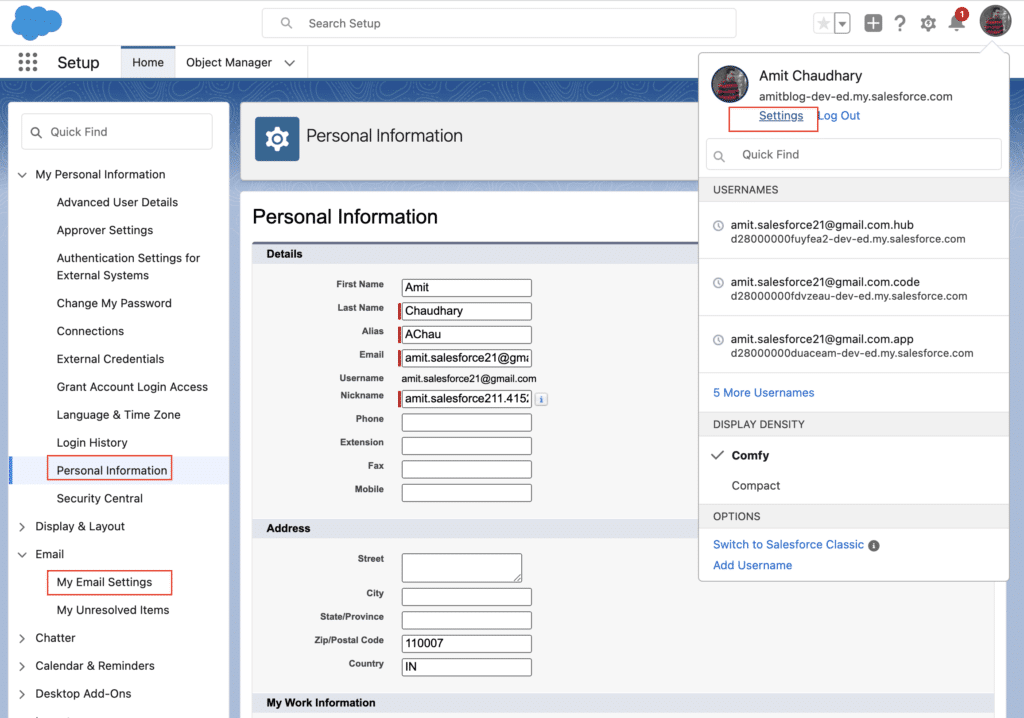
App Launcher
The App Launcher is how users switch between apps.
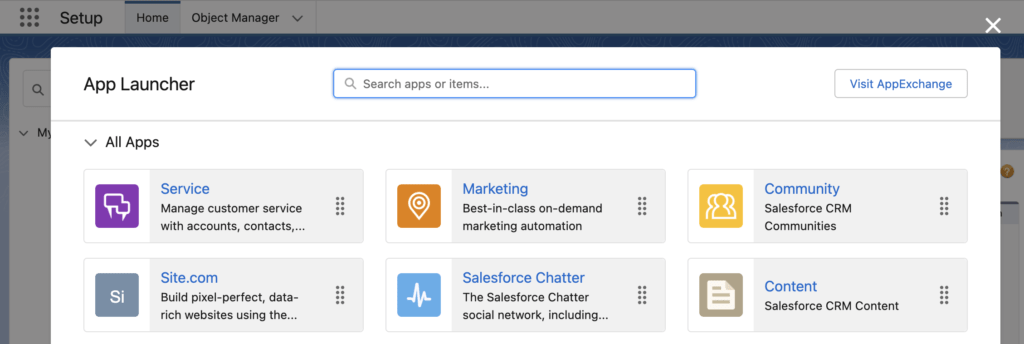
Object Manager
A tool that lets admins access object management and custom objects. With this, we can check all custom and standard objects available in Salesforce.
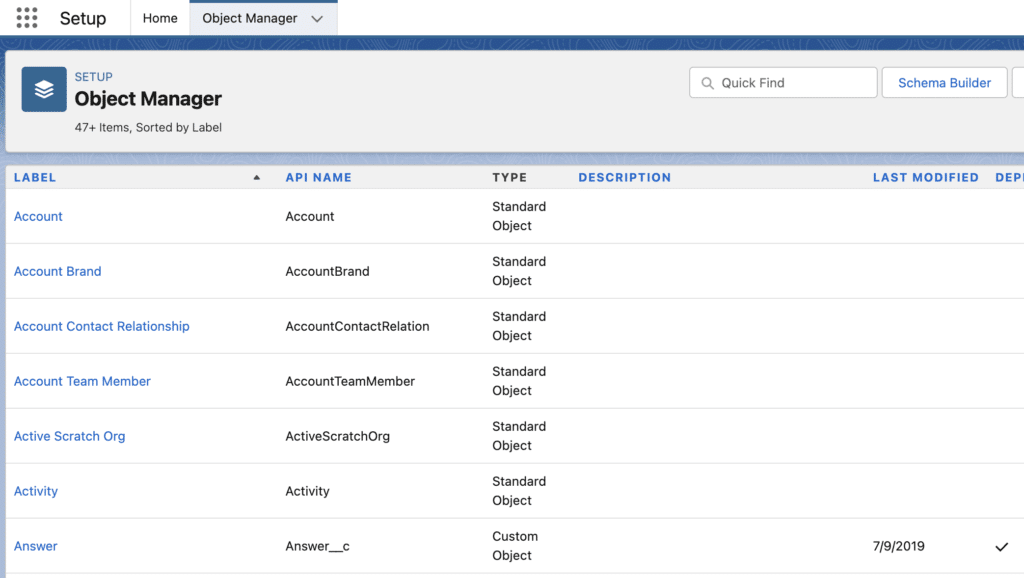
Company Information
Use company information to check sandbox details and available licenses in org and to change the default time zone for the organization.
Setup ➡ Company Information ➡ User Licenses
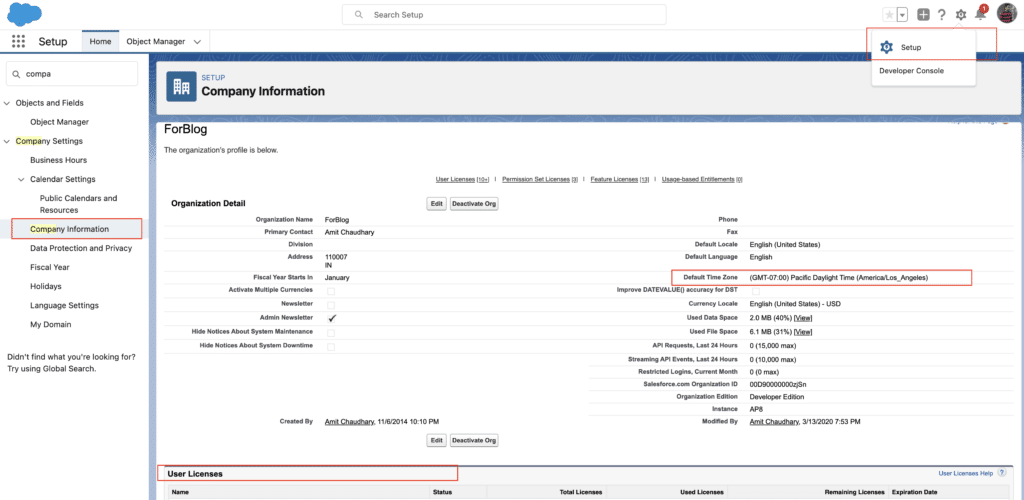
Login Hours
Can we use login Hours to restrict user login access outside of designated hours? You can setup that on profile level.
3. Data Model: 25 %
3.1 Explain the relationship between the core standard objects (account, contact, lead, opportunity, case).
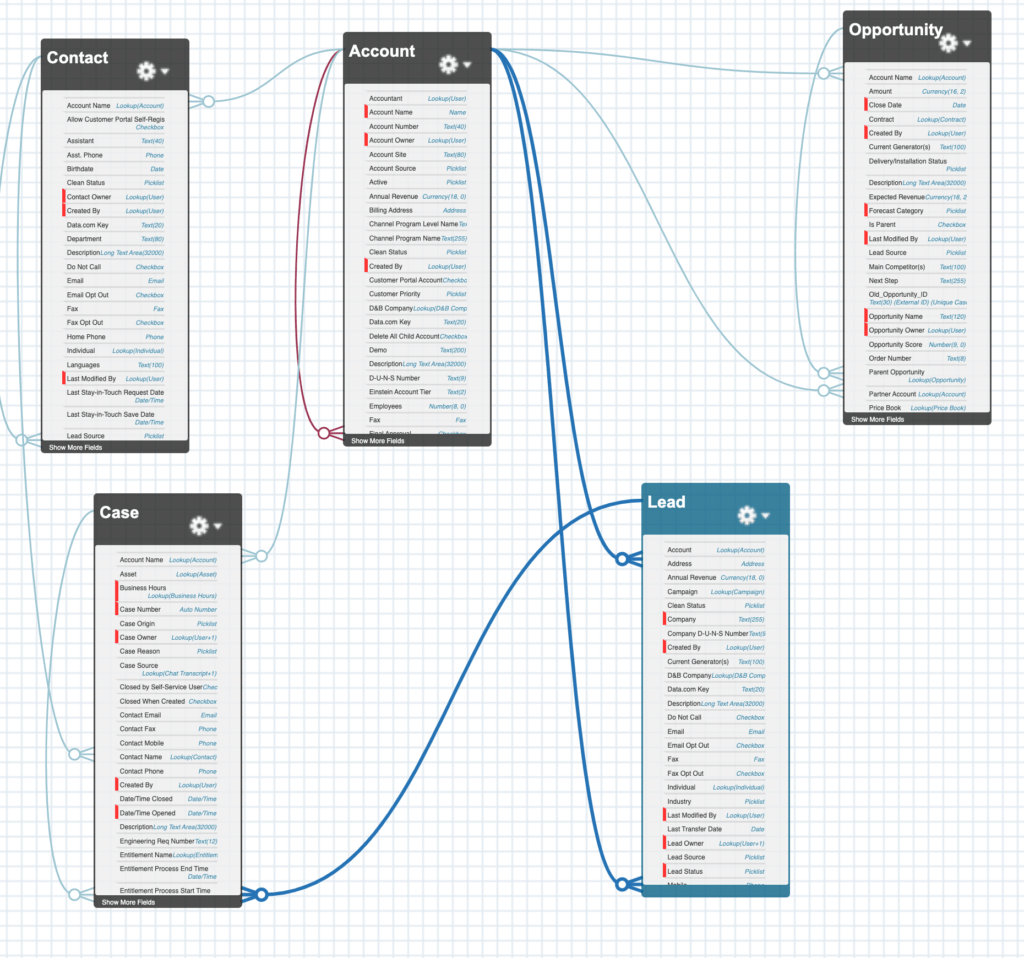
Lead conversation
An account, contact, and optionally opportunity are created.
Field types
- Roll-up summary: A roll-up summary field calculates values from related records, such as those in a related list. You can create a roll-up summary field to display a value in a master record based on the values of fields in a detail record. For example, you want to show the sum of all closed opportunity amounts of the account.
- Number
- Formula
- etc.
You can make a field required with below option
- Page layout: Make the field required on the page layout level.
- Validation rule to make it required.
- Field Level: If you want to make field universally required. Then do it on field level.
Schema Builder
A tool that allows visualization and edits to the data model.
Object Relationships
Following are the different types of relationships available in the Salesforce
- Master-Detail Relationship: Master-Detail relationship is one type of relationship that forms a tight bond relationship between a parent object and a child object. Cascade record deletions. When a parent record is deleted, all its child records get deleted automatically. For example Account is parent of opportunity. If you delete the account record, then all child opportunities will deleted.
- Lookup Relationship: A lookup relationship is one type of relationship that forms a loose bond relationship between a parent object and a child object. For example, Account and contact relationship.
- Many-to-Many: We can create a many-to-many relationship using the Junction object.
- Self Relationship
- External Lookup
- Indirect Lookup
3.2 Given a scenario, determine which feature to use to ensure data visibility.
- Record Types: Used for different business processes, picklist values, and page layouts for different users based on profile.
- Page layouts: use page layout to add field on detail page. Also you can use same to add related list on details page too.
- Dynamic form: Use Dynamic Forms to define the layout of a record detail page that contains fields and sections (what we do with page layouts currently). What makes this dynamic is you can show/hide the sections & fields based on certain filter criteria, which currently is not possible with page layouts. Hence, it provides more granular control to admins and consultants
- Data Security:
- Permission set and Profile
- User Group
- Permission Set Groups: Use to bundle permission set together.
- Queue
- Role Hierarchy: Use Role Hierarchy when you want parent can see all child record but not sibling. For example if you want manager should able to see all his team record.
3.3 Given a scenario, determine which tool to use to ensure data integrity
- Default values
- Data validation rules: Validation rules are best tool to enforce the restriction on records creation like making field required.
4. Reports and Dashboard: 15%
Reports and Dashboards section of the Salesforce Associate exam
4.1 Describe reports on Salesforce.
In its simplest form, a report is a group of data that meets a set of criteria, for example, a group of accounts or opportunities. To get the exact data you need, you can filter, group, and do math on the data in the report. If visuals work better for you, you can view the data in a graph or chart
- Report tab: The Reports tab is the central hub for Salesforce Reports and Dashboards. On the Reports tab you can create a new report, view the existing report and search for reports or dashboards in all folders.
- Use Subscriptions to subscribe the report.
- Conditional formatting
- Bucket fields
- Report folders: Use report and dashboard folders to organize your reports and dashboards. To share reports and dashboards, you share the folder, not the report or dashboard itself.
- Report preview: 2000 rows can be displayed in reports.
- Report types: Report Types are the templates which gives you the ability to create the Reports in a different format
- Types of reports:
- Tabular
- Summary
- Matrix
- Joined Reports
- Report fields:
- Report filters and groups: When you’re using the report builder to ask a question about your data, filters, and filter logic allow you to get more specific. Row limits help you limit the answer you receive.
- Report export:
- Chart Types
Chart Types
| Chart Type | Use |
| Bar Charts | A column chart is very much like a bar chart, but it can be a better format for showing relative counts of things, such as leads or dollars. Use a column chart when you have a summary report with a single grouping or you only want to display one grouping. |
| Column Charts | Use a donut chart when you have multiple groupings and want to show not only the proportion of a single value for each grouping against the total but also the total amount itself. |
| Line Charts | Line charts are good for showing changes in the value of an item over a series of points in time, such as week to week or quarter to quarter. Use a line chart when you have one important grouping representing an ordered set of data and one value to show. |
| Pie Charts | Use a pie chart when you have multiple groupings and want to show the proportion of a single value for each grouping against the total. |
| Donut Charts | Use a donut chart when you have multiple groupings and want to show not only the proportion of a single value for each grouping against the total, but also the total amount itself. |
| Funnel Charts | Use a funnel chart when you have multiple groupings in an ordered set and want to show the proportions among them. |
| Scatter Charts | Use scatter charts to show meaningful information using one or two groups of report data plus summaries. |
4.2 Describe dashboards on Salesforce.
Dashboards offer a powerful visual display of your data around a common theme. For example, you can create a Sales Dashboard that shows you charts and graphs of your company’s sales performance with supporting metrics about your top accounts, top opportunities, win rates, and which account types perform the best.
- Dashboard refresh button:
- Dashboard components:
To learn more about the report and Dashboard, check apex hours session
FAQ
Yes, This is a good start for any fresher to get started in the Salesforce world. This is a good exam to do a quick start for your Salesforce Admin exam.
Yes, if you worked on the Salesforce platform for six months, you cleared this exam on the first attempt.
Check our apex hours FREE Associate course for FREE practice questions.
Summary
I hope this post will help you to become a Salesforce Certified Associate.

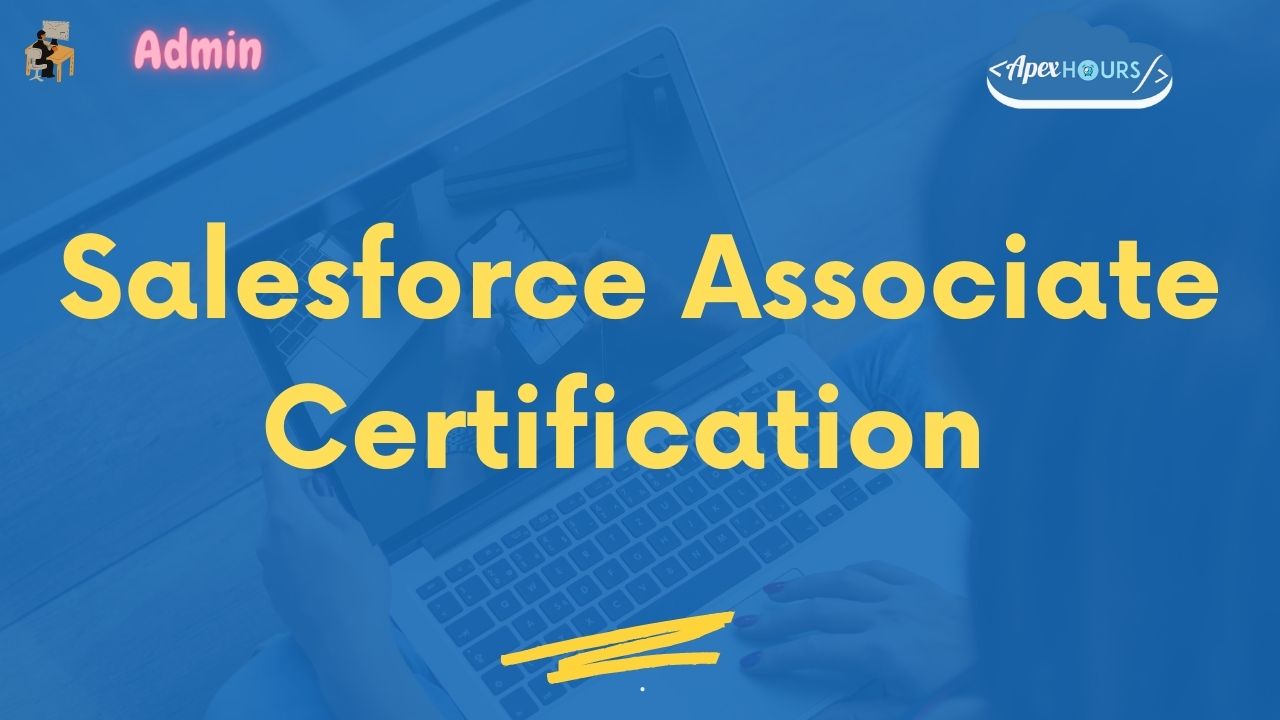




Hi.. For Salesforce associate… Retake is free you mentioned. How many times exam we can retake without fees.
Very good point. It mentions in the Salesforce document https://trailhead.salesforce.com/help?article=Salesforce-Certified-Associate-Exam-Guide.
thanks alot amit !! i have my test on 14th sept so exicted!!
All the best. I hope the above list of topics will help you to prepare for your Salesforce Associate Certification exam. Please share your result after exam.
Will we be able to get a salesforce job with this associate certificate and while working on the job then get an admin certificate or we won’t be able to get a job with this associate certificate?
This is an easy exam for anyone who wants to start a career in the Salesforce ecosystem. Salesforce Associate certification will help you to get a job as a fresher for sure.
Thank you for this post, its very helpful. Is this certification recommended ONLY for folks who don’t have other Salesforce certifications? Will this certification give any extra value if we already have the Salesforce Admin certification?
If you are already a Salesforce Admin then it is not recommended but good to increase your certificate count as this one is easy for certified Salesforce Admin.
I will highly recommend going and becoming a certified Salesforce Associate. All the best for your Salesforce Associate Certification Exam
Great article. Enjoyed reading it.
All the best for your exam. I hope this will help for your Salesforce Associate Exam
Thanks for the detailed information as always. I am planning for career change and your blogs are most helpful ones.Thanks again.
All the best for your Salesforce Associate certification
Hi ,
IF anyone has recently given Salesforce Associate certification exam please share questions here
Hi Poonam,
We don’t support Salesforce Associate Certification Dumps. If you read the above topics, you can complete your exam without any dumps.
Hi Amit,
Great topic refresher! Exam was a breeze with the the items you listed above in mind
Glad post helped you to clear your exam
I have cleared Salesforce associate certification with the help of this this post.
Thank you so much for sharing this. Congratulation.
How can we start ?
How many certifications we require to get a job in salesforce?
There no such rule. it depend on company requirement and your skill to get a job
I didn’t get my certificate
Thank you for this course. Helped me to pass the certification. Quiz after each section helped me to clear my understandings.